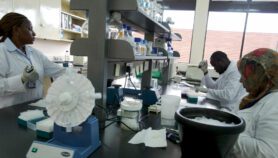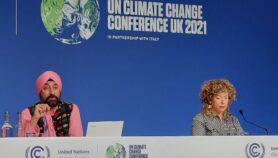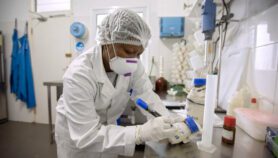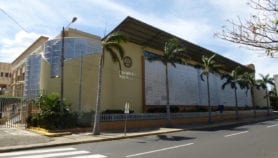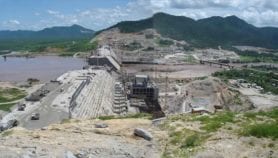Send to a friend
The details you provide on this page will not be used to send unsolicited email, and will not be sold to a 3rd party. See privacy policy.
The White House science office must boost science and technology for international cooperation on many fronts, says Rodney W. Nichols.
Rooting international strategies in sound science means reviewing the role played by the US White House Office of Science and Technology Policy (OSTP) in enabling science and technology (S&T) to inform foreign policy, and overhauling the government’s Agency for International Development (USAID).
The OSTP, headed by the president’s science advisor, has the tough job of overseeing around US$145 billion in 2008 funds — without direct control — while scanning the horizon to assess the nation’s efforts in a worldwide context.
Meeting developing countries’ needs — for genetically modified crops and defences against terrorism for example — presents many challenges for the United States and requires technological savvy in both policy and practice.
In November 2008, a report from the Woodrow Wilson Center in Washington DC (OSTP 2.0) outlined best practices for global responsibilities in the OSTP. These include: leading international S&T policy and activities in organisations such as the G8, World Bank, and all major bilateral and multilateral S&T initiatives; and working with the State Department and USAID, as well as other parts of the US government, to put S&T at the heart of development strategies.
Promoting international collaboration
Corners can’t be cut in fulfilling these tasks. What must be done? The first hurdle is clearing away the litter of misconceptions. In the United States, as in most developed countries, tight science budgets are subject to increasingly stringent tests to justify their contribution to national wealth or productivity — leading to international cooperation being seen as either "giving away knowledge" or a "humanitarian luxury".
Such scepticism is unwarranted. A rising tide of international research collaboration — for example to develop safe and reliable nuclear power — will help lift all the national boats of economic development. Protectionism and hyper-nationalism are the enemies of the world’s scientific progress. Almost all private companies — from General Electric to Microsoft, from Intel to Pfizer — realise that cross-national collaboration in research, development, manufacturing, marketing and distribution is essential. It is time the government does too.
Initial steps for the OSTP, then, are promoting an understanding of the value of participating in international projects and sharing debates about priorities with developing countries. Modern research and development (R&D) toward socio-economic goals absolutely demand global links, and this need intensifies every day.
So S&T must sit at the centre of US foreign policy, not only in security but also in diplomacy and development. And the government’s commitment must rise above party politics and petty turf squabbles, such as those that slashed previously agreed S&T funds in December 2007, brutally zeroing US$150 million for the International Thermonuclear Experimental Reactor — disappointing physicists everywhere and reneging on a solemn promise.
Getting science into USAID
The government’s next big hurdle is reforming the entire ensemble of US foreign aid, which totals almost US$25 billion, to infuse S&T into all goals aimed at improving the lives of people in the developing world.
Reforms of USAID are especially urgent. The agency has a budget of about US$15 billion and is a prime example of the distortions that result when short-run political and bureaucratic actions trump rational priorities. Politically appealing, short-lived programmes are often prioritised over the major sustainable initiatives that underpin long-term development.
USAID has very few senior scientific and engineering staff; a recent estimate is six engineers and 16 agricultural experts — way down from a generation ago. And the agency links poorly to the diverse US community engaged in R&D, meaning it is often too far from the moving fronts of technology.
This isolation is a severe constraint on USAID’s effectiveness on the ground, as are orders from congress to fund ‘think tank’ consultants and traditional aid givers. There should be more competition among fresh bidders exploring new approaches, including ‘do-tanks’ like the US Civilian Research and Development Foundation and action-oriented academic centres with networks of colleagues in developing nations.
Congress should endorse, and USAID assign, its S&T adviser, Nina Fedoroff, the job of establishing a new US$100 million annual R&D fund, focusing on joint efforts to meet the needs of the developing world.
This will mean funding strong R&D in specific fields such as water resources while thinking clearly about the related goal of building human capacity abroad. It also meanshiring highly qualified S&T staff, supporting only the highest quality projects, opening competitions to all comers and rigorously evaluating results.
When this model was used in R&D programmes by the Defense Department it yielded the base for advanced materials, the Internet and electronic miniaturisation. It could help achieve development goals.
The bi-partisan Help Commission has already proposed using such a model for tackling long-range problems — such as reforestation and infrastructure development. Awarding grants and contracts on a competitive basis, the new fund would be administered by a new USAID S&T office and governed by an independent panel of external reviewers. The panel could also advise USAID and the state department on broad technical choices.
The incoming president and congress should act on this initiative. It would go a long way toward putting USAID "in the twenty-first century game".
Rodney W. Nichols is president and chief executive officer emeritus of the New York Academy of Sciences, United States.








